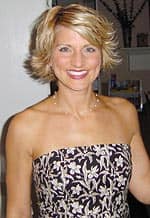Life Extension Magazine®
The horrible tragedy that took place on September 11, 2001, had special meaning for 32-year-old Amy Pomykal. A Dallas-based flight attendant for American Airlines, she was deeply saddened by the loss of her colleagues, but grateful that fate had been kind to her that day. In the month following the tragedy, she took a leave of absence from work, uncertain about whether she wanted to continue flying or what to do next. The only thing she could say for certain was, “life is short, I just want to live life.” It would prove to be a prophetic statement, one that would come back to haunt her just months later. Amy engaged in a whirlwind of experiences before her scheduled return to flying on May 1, 2002. She considered career changes, discussed starting a family with her husband Tim, worked two jobs, volunteered at a children’s hospital, and won the Mrs. Dallas County pageant. With a world of possibilities seemingly open to her, everything suddenly changed on Saturday, April 27, 2002. An Unforeseen TragedyAfter spending the day shopping with her sister Keri McClure, Amy felt unusually tired that evening. She shooed her concerned sister home and lay down on the sofa to relax. It would be the last thing she remembers of that day. Tim came home to find his wife curled in a fetal position on the kitchen floor. As he grabbed the phone to call 911, Amy had a seizure. She had two more seizures waiting for paramedics to arrive, then a fourth one on her way to Baylor Medical Center in downtown Dallas. Paramedics gave her Valium® to prevent brain damage. At the emergency room, the first diagnosis stunned Amy’s family. “They thought I was on drugs, because it was Saturday night at 9:30,” she says. “They didn’t do anything with me for several hours, thinking I’d come out of it, or that if it were epilepsy, the seizures would stop. But I didn’t come out of the state I was in.” Amy’s family was adamant that she did not drink or use drugs. The hospital kept her overnight and an MRI was ordered the following morning. Doctors quickly delivered the devastating news: they were 90% certain she had a brain tumor, and the prognosis was not good. “They said it was inoperable and malignant,” Amy recalls. “They basically told me my days were numbered. I tried to get off the bed to find a trash can or a bed pan to throw up in. I felt like I was going to die. I remember being angry.” Her physicians discussed performing a burr-hole procedure, in which a surgeon drills a small hole in the skull and inserts a needle to remove a tissue sample from the tumor to ascertain its type and thus how to treat it. However, Amy’s family was uncomfortable with the risky procedure. Amy herself was incapable of making decisions and unable even to speak because the tumor affected her brain’s speech center. Her husband and sister took over as her advocates. It proved to be a good pairing, Amy says. Her husband Tim was conservative and hesitant to leap into unknown territories; he wanted to take time to consider everything the doctors said. Keri was more daring, willing to seek out and try anything that might save her sister. Together, Tim and Keri balanced and helped each other keep perspective. A Proactive ApproachTheir first decision was to move Amy to another medical facility. Keri also took to the Internet to search for information. On a site called VirtualTrials.com, which provides information on clinical trials and treatments for brain tumors, she found what she was looking for. “I read firsthand patient experiences, including the journals of Ben Williams, a brain-cancer survivor from California,” Keri says. “He had so much information on supplements he took and why he took them, and he mentioned the Life Extension Foundation as an excellent resource for quality supplements.”
Keri researched Williams’ supplement program and immediately put her sister on the same protocol of nutrients. There were so many supplements that she organized them in a fishing tackle box. Meanwhile, on a friend’s recommendation, Tim and Keri took Amy to Plano Medical Center, where they were told that Amy’s tumor was an arteriovenous malformation, or AVM, an abnormal collection of blood vessels. It was operable, the doctors said, though doubtful that all of it could be removed. Surgery gave Amy a shot, albeit a long shot, at staying alive. But what kind of life would it be? “I was told I’d be okay for a few months, but then I’d have seizures again,” she recalls. “My brain would become more damaged each time. It was gloom and doom in a big way, and I cried my eyes out.” But surgery was the only hope, with chemotherapy and radiation to follow. Having read the Life Extension protocols on those subjects, Keri knew that radiation to the brain could cause extensive memory loss. To protect Amy’s brain as much as possible, Keri incorporated the protocols’ supplement recommendations in Amy’s program. Although Tim was not convinced, he gradually became braver, Keri says. “Once he saw that other survivors had taken the protocols, he went along with it,” Keri explains. “We tapped into Life Extension and learned that there’s solid evidence, solid research, and it gave him confidence that we were doing the right thing.”
Surviving Surgery and ChemoAmy’s family still wanted more opinions and sought the right surgeon to perform the operation. Amy went to several medical centers, all within a week after her first seizure. They decided to have the surgery performed at the University of Texas Southwestern Medical Center, where they received yet another diagnosis: anaplastic glioblastoma, a type of tumor that develops from the glial cells composing the brain’s supportive tissue. This type of tumor is recognized as one of the most deadly of all, and Amy’s was growing rapidly. Surgery was scheduled immediately. The surgery took nearly eight hours. Amy recovered rapidly, and soon afterwards was able to walk and speak again. While not all of the tumor had been removed, Amy felt well and was upbeat. She went home to prepare for simultaneous chemotherapy and radiation to begin two weeks later, knowing that, statistically, her chances were not good. “Even with radiation and chemo, most people die from this type of tumor anyway,” Amy says. “You have to keep fighting it whatever way you can.” Amy surprised even herself with her stamina during chemotherapy and radiation, and she credits her supplement program. She had enough energy to play tennis twice a week, and after a month on radiation, she still had most of her hair. Amy stopped chemotherapy in November 2002. Although her doctors spoke optimistically, she knew there was nothing more they could do for her. Still feeling fine, she ran a marathon on December 2. “Probably not the brightest thing I’ve ever done,” she says. “But I lived through it. I visualized my tumor shrinking, visualized myself being older. I prayed a lot for strength and the ability to make good decisions.”
A Promising VaccineTrying to decide what to do next, Keri learned of cutting-edge clinical trials of a cancer vaccine at the Brain Tumor Center at Duke University Medical Center. She wanted her sister to get into the trial of the dendritic cell vaccine, under the direction of John Sampson, MD, PhD. Dendritic cells trigger an immune response by activating killer T cells against foreign substances, such as bacteria, viruses, and tumors. Studies have shown that if the patient’s dendritic cells are cultured with RNA from the patient’s tumor, they produce a strong immune response against the cancer cells. Although the trial was closed, Dr. Sampson opened it for Amy. Supplement tackle box in hand, Amy flew to Duke for her first injection in late May 2003 and every two weeks thereafter for six weeks, receiving the last dose on July 21. She returned to Duke three months later for an MRI, and the scan showed definite improvement. Returning again in January 2004 for another scan, her doctors had a surprising announcement. “They said they don’t use the words ‘cure’ or ‘remission’ for brain cancer, but said ‘for right now, you’re cured,’” says Amy. “They said the tumor’s not there anymore. All that showed up on the scan was a small spot they thought was probably scar tissue from the surgery.” Henry Friedman, MD, co-director of the center’s clinical neurooncology program, says that empowering patients about their care is the way to achieve the best results. To that end, patients are permitted to continue alternative treatments they believe in, as long as they are honest about what they are taking and nothing they take has a known toxicity. “We have no proof that what she’s doing might hurt her, and it might help her. We don’t know the answer,” says Friedman. “We could say the same things about what we’re doing. I think it’s enlightened medicine. It’s admitting where you don’t know what’s going to go on, yet following ‘Do no harm.’” Amy believes she is cured. She receives periodic MRIs and looks forward to her visits to Duke. Although she has some memory deficit, occasionally has to search for words, and still takes anti-seizure medication, those around her say she is the picture of health, and she has even returned to her job at American. Nevertheless, Amy is ever mindful that life is precious. She no longer lets little things bother her. She is thinking once again about starting a family. She has adjusted her priorities. And she still takes her supplements. “I believe the supplements did a lot, and I know I’ll be taking them for the rest of my life,” she says. “I think it’s amazing that I was given such a diagnosis and I’ve done well through the whole thing. I believe it’s my supplements, my mental attitude, and my faith. I believe that I’m going to live. I’m going to survive.”
|




